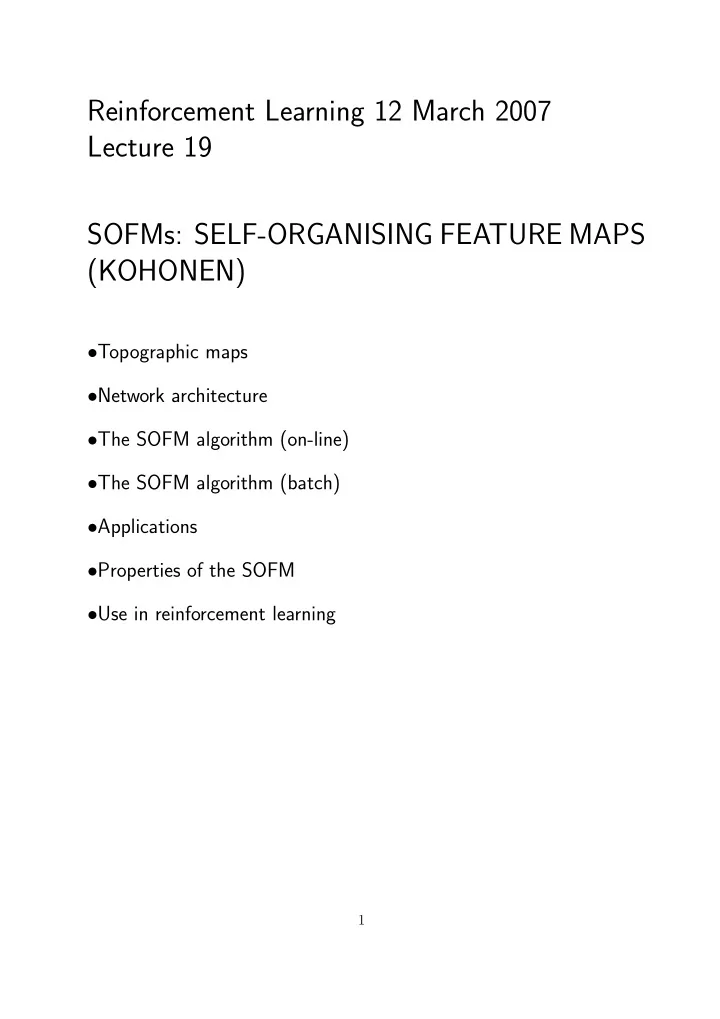

Reinforcement Learning 12 March 2007 Lecture 19 SOFMs: SELF-ORGANISING FEATURE MAPS (KOHONEN) • Topographic maps • Network architecture • The SOFM algorithm (on-line) • The SOFM algorithm (batch) • Applications • Properties of the SOFM • Use in reinforcement learning 1
TOPOGRAPHIC MAPS • Topographic = topology preserving – neighbouring places in the world are found in neighbouring places in the map • Topographic maps are found in biological systems, e.g. the retino- topic map from the retina to visual cortex, the somatosensory map and tonotopic map • In the visual cortex, adjacent neruons have adjacent visual receptive fields, and collectively they constitute a map of the retina • SOFM (or SOM) developed by Kohonen since 1982 • Builds on ideas of Willshaw and von der Malsburg about how retino- topic maps are wired up 2
CLUSTERING • Self -organising map similar to a clustering algorithm, except that there is an additional constraint • Cluster centres are embedded in another space (the output space) and points that are nearby in the input space must map to points that are nearby in the output space • So when we update a cluster centre, we also update its neighbours. • Has the effect of keeping close-by units in the ouput space mapping to close-by regions of input space 3
KOHONEN ARCHITECTURE 2−d array of output or map units only a few interlayer connections shown Input units • Input has dimension d , i.e. d units • Array – usually 1D or 2D – of grid/map/output units on a rectan- gular or hexagonal grid • Each input unit is connected to each grid unit • Neighbourhood relations calculated on this grid • An example input could be ( x, y, ˙ x, ˙ y, θ ) for position, velocity and orientation of a robot • Each grid unit j has a vector w j associated with it, of the same dimension as the input 4
THE SOM ALGORITHM Initialise a grid of units to have weight vectors w j set to random values Loop until weights change by only tiny amounts Take a sample input x Find the winning map node i ∗ that best matches the input: i ∗ = arg min j � x − w j � Update the winning weight vector and the weights of those nodes in its neighbourhood: w j ( t + 1) = w j ( t ) + η ( t ) N t ( j, i ∗ )( x − w j ( t )) The learning rate η ( t ) needs to decrease during the learning, as does the width of the neighbourhood function N t ( j, i ∗ ) . We start with N having a wide range and narrow it down, and η starts large and is successively reduced to zero. 5
NEIGHBOURHOOD FUNCTIONS 1 0 −k k distance from winning node in map grid units top−hat Gaussian 1 0.8 0.6 0.4 0.2 0 −2 −1 0 1 2 6
SOM BATCH ALGORITHM Luttrell (1990), Kohonen (1993) Initialise the grid of units to have weight vectors w j set to random values Loop until terminated • for k = 1 to K (number of data vectors) find the best matching (winning) unit i ∗ ( k ) = arg min j � x k − w j � end for • Update the weight vectors using k =1 x k N ( i ∗ ( k ) ,j ) � K w j = � K k =1 N ( i ∗ ( k ) ,j ) End loop 7
PRACTICAL ISSUES • Grid: –dimension? –size? –topology? • Typical training regimes: –Sort out gross structure in early iterations –Fine structure later • Preprocessing of input signals + scaling PROPERTIES OF THE SOM After convergence, the map will have the properties: • Topological Ordering (as far as possible given the topology of the output space) • Density Matching There will be more units in high-density regions of the input space 8
APPLICATIONS • Many! Thousands of SOM papers • Phonetic typewriter (early application by Kohonen) – Convert short (about 10ms) slices of sound to 15 frequency bands + volume – Train network on 16D vectors – Label network with phoneme names – Rule-based post-processing improves recognition accuracy • Robot map-making 9
Recommend
More recommend